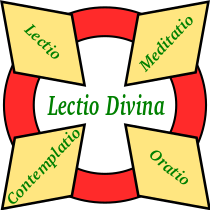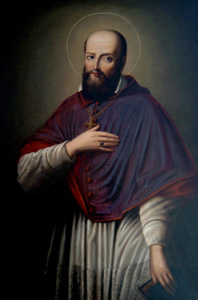Christian meditation
 |
| Part of a series on |
| Christian mysticism |
|---|
Christian meditation is a form of prayer in which a structured attempt is made to become aware of and reflect upon the revelations of God.[1] The word meditation comes from the Latin word meditārī, which has a range of meanings including to reflect on, to study, and to practice. Christian meditation is the process of deliberately focusing on specific thoughts (such as a Bible passage) and reflecting on their meaning in the context of the love of God.[2]
Christian meditation aims to heighten the personal relationship based on the love of God that marks Christian communion.
Context and structure
This section may require cleanup to meet Wikipedia's quality standards. The specific problem is: This section is written referring only to Christian metaphysics. It does not objectively explain what the practitioner of meditation actually does when meditating. Are these reflections on aspects of Christian metaphysics discursive thoughts and reasoning or non-discursive inner visualizations? What kind of actions is the mind performing when meditating? (March 2024) |
Christian meditation involves looking back on Jesus' life, thanksgiving and adoration of God for his action in sending Jesus for human salvation.
By meditation I mean prolonged reasoning with the understanding, in this way. We begin by thinking of the favor which God bestowed upon us by giving us His only Son; and we do not stop there but proceed to consider the mysteries of His whole glorious life.[14]

Quoting the
The dimensions of Christian meditation develop from God's having completed his self-revelation in two directions: Speaking out of his own, and speaking as a man, through his Son, disclosing the depths of man.... And this meditation can take place only where the revealing man, God's Son, Jesus Christ, reveals God as his Father: in the Holy Spirit of God, so we may join in probing God's depths, which only God's Spirit probes.[17]
Building on that theme,
Role of the Holy Spirit
In Western Christian teachings, meditation is usually believed to involve the inherent action of the
In the 19th century, Charles Spurgeon affirmed this belief within the Protestant tradition and wrote: "The Spirit has taught us in meditation to ponder its message, to put aside, if we will, the responsibility of preparing the message we've got to give. Just trust God for that."[27] In the 20th century, Hans Urs von Balthasar paraphrased this teaching as follows:[25]
The vistas of God's Word unfold to the meditating Christian solely through the gift of the Divine Spirit. How could we understand what is within God and is disclosed to us except through the Spirit of God who is communicated to us?
As a biblical basis for this teaching, von Balthasar referred to 1 Corinthians 2:9-10: "these are the things God has revealed to us by his Spirit. The Spirit searches all things, even the deep things of God".:[25]
Distinction from non-Christian meditation
Christian meditation is generally held to be distinct from the styles of meditations performed in Eastern religions (such as
Modern Christian teachings on meditation at times include specific criticism of the
A 1989 document generally known as
Some authors, however, have emphasized similarities between Christian meditation and non-Christian meditation. Psychologist
Comparison to non-Christian meditation
Meditation and prayer can mean different things depending on the religion, sect, school, or individual. Some even believe that meditation and prayer can mean the same thing. Scholar, Rita Gross notes in her article "Meditation and Prayer: A Comparative Inquiry",[44] that there is an incorrect stereotype that Buddhist meditation is only a quiet and solitary practice, when in reality many Tibetan Buddhist use the word 'prayer' quite frequently as they even direct their prayers to being separate from themselves. Gross discusses the similarities in the way Christian prayers are also used as petitions, pleading for some sort of action or emotion from God. The discussion of prayer and meditation can be an intimate and sacred topic, as Gross has portrayed it here.
Another article regarding the comparison of Buddhist and Christian prayer is Robert Aitken's "Formal Practice: Buddhist or Christian."[45] Aitken details seven different Buddhist practices and describes how they might connect with Christian practices. To name just a couple, the sange, is nearly the same practice as Christian confession, both involve a daily expression of wrong doings, with the intention of realizing the good, being the Dharma for Buddhist and God for Christians. Another Buddhist practice described to support Aitken's argument is the Nembutsu, a chant, or prayer, meant to elicit an influential super-being in Buddhism, Amida. No doubt there is a comparison that Aitken draws here between Christian prayer to God and the Buddhist Nembutsu.
Additionally, Kyeongil Jung writes of his own personal journey to find peace, or liberation from suffering, as he is consistent and engaged in both Christianity and Buddhism. Jung paints this complex scene in which it is possible to find liberation through these two religious paths, yet there are also four main dichotomies that he presents which he has climbed over in his own spiritual walk. The last one is of relevance to this section on meditation. Jung presents a more abstract case of a congenial plight on mindfulness; mediation and action, finding that there isn't one that comes without the other first. He asserts that "morality [social practice/action] and meditation strengthen and cultivate each other."[46] He presents two anecdotes to demonstrate that mindfulness and movement are both synonymous and cyclical in practice.
Old Testament references
In the Old Testament, there are two Hebrew words for meditation: hāgâ (Hebrew: הגה), which means to sigh or murmur, but also to meditate, and sîḥâ (Hebrew: שיחה), which means to muse, or rehearse in one's mind. When the Hebrew Bible was translated into Greek, hāgâ became the Greek melete which emphasized meditation's movement in the depth of the human heart. Melete was a reminder that one should never let meditation be a formality. The Latin Bible then translated hāgâ/melete into meditatio.[47]
The Bible mentions meditate or meditation 23 times, 19 times in the
History
During the Middle Ages, the monastic traditions of both Western and Eastern Christianity moved beyond vocal prayer to Christian meditation. These progressions resulted in two distinct and different meditative practices: Lectio Divina in the West and hesychasm in the East. Hesychasm involves the repetition of the Jesus Prayer, but Lectio Divina uses different Scripture passages at different times and although a passage may be repeated a few times, Lectio Divina is not repetitive in nature.[51][52]

The progression from Bible reading, to meditation, to loving regard for God, was first formally described by Guigo II, a
In Eastern Christianity, the monastic traditions of "constant prayer" that traced back to the Desert Fathers and
The methods of "methodical prayer" as taught by the
During the 18th and early 19th centuries, some components of meditation had started to be de-emphasized in some branches of Western Christianity.[57] However, the early part of the 20th century witnessed a revival and books and articles on approaches such as Lectio Divina aimed at the general public began to appear by the middle of the century.[57]
In 1965, one of the principal documents of the Second Vatican Council, the dogmatic constitution Dei verbum (Latin for Word of God), emphasized the use of Lectio Divina and on the 40th anniversary of Dei verbum in 2005 Pope Benedict XVI reaffirmed its importance.[58]
Approaches to meditation
A number of
St. Ignatius of Loyola
The
The exercises are intended as notes to guide a spiritual director who is leading someone else through an experience of Christian meditation. The entire experience takes about 30 days and often involves a daily interview with the director. The process begins with a consideration of the purpose of one's life and the relationship with the rest of creation. It is followed by a week of meditation about sin and its consequences. Next comes a period of meditating on the events of the life of Jesus, and another for thinking about his suffering and death. The final week is to experience the joy of the resurrection, and in conclusion to reflect on God's love and the response of love for God.[61]
The exercises often involve imagery in which one enters a biblical scene. For example, the practitioner is encouraged to visualize and meditate upon scenes from the life of Christ, at times asking questions from Christ on the cross, during
St. Teresa of Avila
St. Teresa of Ávila (1515–1582) a Doctor of the Church, practiced contemplative prayer for periods of one hour at a time, twice a day. St. Teresa believed that no one who was faithful to the practice of meditation could possibly lose his soul.[64] Her writings are viewed as fundamental teachings in Christian spirituality.[65][66]
St. Teresa taught her nuns to meditate on specific prayers. Her prayers described in
In her Life, she wrote that she taught herself from the instructions given in the book, The Third Spiritual Alphabet – by
St. Theresa viewed Christian meditation as the first of four steps in achieving "union with God", and used the analogy of watering the garden. She compared basic meditation to watering a garden with a bucket, Recollection to the water wheel, Quiet (contemplation) to a spring of water and Union to drenching rain.[31]
Early studies on states of consciousness by
Saint Francis de Sales

- In the preparation part, one places oneself in the presence of God and asks the Holy Spirit to direct the prayer, as in the Epistle to the Romans:[78] "The Spirit helps us in our weakness, for we do not know what to pray for, but the Spirit himself intercedes for us with sighs too deep for words."
- In the consideration part, one focuses on a specific topic, e.g. a passage from the Bible.
- In the affections and resolutions part, one focuses on feelings and makes a resolution or decision. For instance, when meditating on the Parable of the Good Samaritan one may decide to visit someone sick and be kind to them.
- In the conclusion part, one gives thanks and praise to God for the considerations and asks for the grace to stand by the resolution.
Other approaches
By denomination
Catholic Church

Saint Thomas Aquinas (1225–1274) said that meditation is necessary for devotion, and the Second Vatican Council called for "faithful meditation on God's word" as part of the spiritual formation of seminarians.[81]
The Catechism of the Catholic Church encourages meditation as a form of prayer: "Meditation is above all a quest. The mind seeks to understand the why and how of the Christian life, in order to adhere and respond to what the Lord is asking" (Catechism section # 2705) and that Christians owe it to themselves to develop the desire to meditate regularly (# 2707). Emphasizing union with God, it states: "Meditation engages thought, imagination, emotion, and desire. This mobilization of faculties is necessary in order to deepen our convictions of faith, prompt the conversion of our heart, and strengthen our will to follow Christ. Christian prayer tries above all to meditate on the mysteries of Christ, as in lectio divina or the rosary. This form of prayerful reflection is of great value, but Christian prayer should go further: to the knowledge of the love of the Lord Jesus, to union with him" (#2708).[83] Meditative prayer is different from contemplative prayer (See CCC 2709-2724).
Pope Francis said that meditation is a need for everyone.[84][85] He noted that the term "meditation" has had many meanings throughout history, and that "the ancients used to say that the organ of prayer is the heart."[84] Pope Francis stated that "The prayer of the Christian is first of all an encounter with the Other, with a capital "O": the transcendent encounter with God...That is, meditating means going – guided by a phrase from the Scripture, from a word – to the encounter with Jesus within us...And in this way, only in this way, can we find ourselves."[84][85]
Eucharistic meditation

Christian meditation performed with
Saint Thérèse of Lisieux was devoted to Eucharistic meditation and on February 26, 1895, shortly before she died, wrote from memory and without a rough draft her poetic masterpiece "To Live by Love", which she had composed during Eucharistic meditation.[89][90]
Significant portions of the writings of the
Rosary meditations
Meditation is an integral part of the
Saint
Eastern Christianity
During the
In hesychasm, the Jesus prayer, consisting of the phrase: "Lord Jesus Christ, Son of God, have mercy on me" is repeated either for a set period of time or a set number of times. Hesychasm is contrasted with the more mental or imaginative forms of Christian meditation in which a person is encouraged to imagine or think of events from the life of Jesus or sayings from the Gospel. Sometimes hesychasm has been compared to the meditative techniques of oriental religions and it is possible that there were interactions between Hesychasts and
See also
- Christian meditation music
- Christian mysticism (contemplation)
- Daily devotional
- The Cloud of Unknowing
Further reading
- de la Puente, Lius (1852). . Richarson and Son.
- Roger Baxter (1823). . Benziger Brothers.
- Richard Challoner (1801). . R. & W. Dean & Co.
- Thomas à Kempis (1908). . Kegan Paul, Trench, Trubner & Co.
Notes
- ISBN 0-88489-361-8page 7
- ISBN 81-7109-429-5pages 76–77
- ^ ISBN 1-57383-227-8pages 12–13
- ^ ISBN 90-04-12654-6page 488
- ISBN 0-7425-5084-2page 134
- ISBN 0-89870-068-Xpage 180
- ISBN 0-88141-250-3 St Vladimir Press, "Chapter 2: Degrees of Prayer" pages 39–42 [1]
- ISBN 0-571-19165-7pages 63–65
- ^ ISBN 0-7618-2747-1page 236
- ^ ISBN 1-4209-2847-3page 145
- ^ ISBN 0-8132-0754-1page 238
- ISBN 0-521-43991-4page 211
- ISBN 0-8028-3708-5page 210
- ^ ISBN 0-85244-403-6page 4
- ^ 11:27
- ^ 2:12
- ISBN 0-89870-235-6pages 9-10
- ^ 4:19
- ISBN 0-8146-0412-9page 105
- ISBN 0-631-21281-7pages 67-72
- ^ 9:16
- ISBN 1-57383-227-8page 48
- ISBN 1-57383-227-8page 27-28
- ISBN 0-8091-4531-6page 36
- ^ ISBN 0-89870-235-6pages 27–30
- ISBN 978-0-8091-3664-3pages 184–187
- ^ ISBN 978-0-631-21281-2pages 84-87
- ISBN 978-0-8307-4187-8page 178
- ISBN 1-57383-227-8pages 7–13
- ISBN 1-57683-027-6 Chapter 3, Part2: Meditating on God's Word [2]
- ^ ISBN 0-8192-1914-2page 98
- ISBN 0-8146-6012-6page 311
- ISBN 1-57958-250-8page 695
- ISBN 0-8254-3492-0page 19
- ISBN 1-57383-227-8page 12
- ISBN 1-57383-227-8page 29
- ^ Vatican website: Letter on certain aspects of Christian meditation (in German), October 15, 1989
- ^ EWTN: Letter on certain aspects of Christian meditation (in English), October 15, 1989
- ISBN 0-7425-3178-3Page 74
- ^ Steinfels, Peter (1990-01-07). "Trying to Reconcile the Ways of the Vatican and the East". New York Times. Retrieved 2008-12-05.
- ISBN 978-0-87477-833-5. p. 104-113.
- ^ Conjectures of a Guilty Bystander p. 285.
- ^ a b Solitary Explorer: Thomas Merton's Transforming Journey p. 105.
- S2CID 170665551.
- S2CID 170671678.
- S2CID 170348557.
- ISBN 0-8091-3660-0page 88
- ^ "Search | ESV.org". ESV Bible. Retrieved 2018-03-11.
- ^ Joshua 1:8
- ^ "Bible Gateway passage: Joshua 1:8 - English Standard Version". Bible Gateway. Retrieved 2018-03-11.
- ^ ISBN 978-1-4411-2547-7pages 31–38
- ISBN 0-8264-6084-4page 44
- ISBN 978-0-8091-3660-5pages 38–39
- ISBN 0-8146-6012-6pages 207–208
- ISBN 0-913836-81-8page
- ^ ISBN 1-900755-96-3page 28
- ^ ISBN 0-87907-231-8pages 188–195
- ^ Vatican website Address at the 40th anniversary of DEI VERBUM, Friday, 16 September 2005
- ^ ISBN 0-521-43991-4page 211
- ISBN 1-60206-373-7page 15
- ISBN 1-85311-623-8page 203
- ISBN 0-88706-109-5pages 123-125
- ISBN 0-8146-6012-6page 413
- ISBN 0-8146-0412-9page 108
- ISBN 0-8264-7341-5page vii
- Catholic encyclopedia. Retrieved 14 April 2010.
- ISBN 0-8091-3660-0page 96
- ISBN 1-59030-573-6page 20
- ISBN 0-8146-6012-6pages 413-415
- ISBN 0-8264-7341-5page 4
- ISBN 1-60206-260-9page 160
- ISBN 0-87395-937-Xpage xvii
- ISBN 0-8264-7341-5page 66
- ISBN 0-385-50129-3page 64
- ^ Roland Fischer (1971), A Cartography of the Ecstatic and Meditative States. In Science, Vol 174 Num 4012 26 November 1971
- ^ Saint Teresa, The Life of Saint Teresa, J.M. Cohen, Transl. (Penquin, Baltimore, 1957), p. 142.
- ISBN 81-7109-429-5pages 77-78
- ^ 8:26
- ISBN 0826413749page 24
- ISBN 0-8294-2024-Xpages 79 and 86
- ISBN 1-59276-094-5page 350
- ISBN 0-7914-0887-6page 168
- ISBN 0-86012-324-3pages 570–615
- ^ a b c "Pope at Audience: Meditating is a way of encountering Jesus - Vatican News". www.vaticannews.va. 2021-04-28. Retrieved 2022-12-19.
- ^ a b kathleenaleteia (2021-04-28). "Meditation is more than a self-help trend, explains Pope". Aleteia — Catholic Spirituality, Lifestyle, World News, and Culture. Retrieved 2022-12-19.
- ^ The Real Presence: Eucharistic Meditations by Saint Pierre Julien Eymard, Sentinel Press, 1938 ASIN B00087ST7Q
- ^ The Eucharistic Meditations of the Curé d'Ars by Saint Jean Baptiste Marie Vianney Carmelite Publications (1961) ASIN B0007IVDMY
- ISBN 0-940147-03-3
- ISBN 0-8028-3836-7page 245
- ISBN 0-85244-547-4page 75
- ISBN 0-8189-0890-4
- ISBN 1-59276-441-Xpage 255
- ^ Vatican Website
- ISBN 0-86012-320-0page 200
- ISBN 1-57958-090-4page 246
- ISBN 0-7546-5121-5page 261
- ISBN 2-89420-545-7page 18
- ISBN 2-89420-545-7page 19
- ^ Rosarium Virginis Mariae, #3
- ^ "Mount Athos: History". Macedonian Heritage. Archived from the original on December 7, 2009. Retrieved 12 May 2010.
- ISBN 0-631-23203-6page 230
- ^ Dawood, Bishoy (8 December 2013). "Stand, Bow, Prostrate: The Prayerful Body of Coptic Christianity : Clarion Review". Clarion Review. Archived from the original on 13 August 2023. Retrieved 27 July 2020.
- Catholic encyclopedia. Retrieved 14 April 2010.
- ISBN 1-59276-026-0page 433
- ISBN 0-521-66738-0page 128
External links
- World Community for Christian Meditation
- Center for Action and Contemplation
- The Interior Castle by St. Teresa of Avila online (CCEL)
- Instructions on Meditation & Guided Meditations by the Saints
- Contemplative Outreach - Thomas Keating OCSO
- The Spiritual Exercises of St. Ignatius of Loyola (tr. Mullan)
- The Rosary as a Tool for Meditation
- Christian Meditation - AOG

